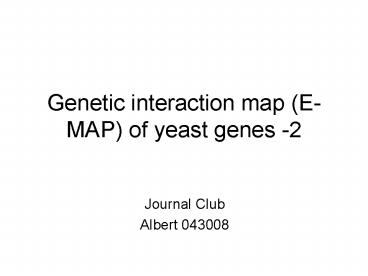Genetic interaction map EMAP of yeast genes 2 - PowerPoint PPT Presentation
1 / 35
Title: Genetic interaction map EMAP of yeast genes 2
1
Genetic interaction map (E-MAP) of yeast genes -2
- Journal Club
- Albert 043008
2
(No Transcript)
3
(No Transcript)
4
Introduction-1
- Defining the functional relationships between
proteins large-scale identification of protein
complexes genetic interactions - SSL (synthetic sickness/lethal) SGA or dSLAM
5
SGA SLAM
Nature Genetics 35, 204 - 205 (2003)
6
Introduction-2
- SSL interactions hard to interpret the
- Patterns of genetic interactions (GI)
informative to identify functional related genes - Negative GI 2 proteins act in different parallel
pathways - Positive GI 2 proteins act together in a common
pathway
7
Simplified examples
Negative (aggravating) interactions
Synthetic lethal
Positive (alleviating) interactions
Complete buffering
?x
?Y
Suppression
8
Introduction-3
- E-MAP (epistatic miniarray profile)
quantitative measurements of the genetic
interactions between pairs of mutations within a
subset of genes linked to specific biological
processes
9
Why E-MAP ? (epistatic miniarray profiles)
- Enormous number of gene pairs and low density of
interactions special process - Quantitative comparison between the growth of SM
and DM for positive interaction detection (not
only SSL)SGA - Difficult to generate hypomorphic alleles of
essential genes -DAmP
10
Whats DAmP?(Decreased Abundance by mRNA
Perturbation)
Selection marker Nourseothricin
Nature promoter
Destabilizing corresponding mRNAs
11
The implementation and robustness of the DAmP
approach
Greatly reduced
Western blot
Tetrad analysis
Strong aggravating
12
Why ESP ?(yeast early secretory pathway)
- Spatially restricted
- Central function (lipid biosynthesis and
translocation, folding, processing, and
trafficking of secreted proteins)
13
Construct an E-map in ESP
- 424 identify genes related ESP
- 367 non-essential gene deletion
- 57 essential gene DAmP strains (function or
localization)
Functional categories (literature review)
14
Paper2 samples
- 754 alleles of 743 genes involved in various
aspects of chromosome biology (DNA
replication/repair, chromatid segregation and
transcriptional regulation) - 663 non-essential genes
- 70 essential genes constitutive hypomorphic
alleles
15
(No Transcript)
16
The range of colony sizes
Interaction scores for each gene pairs
17
Distribution of significant aggravating
interactions for strains of different functional
groups
18
Hierarchical-Cluster Analysis of ESP E-Map
19
Two key considerations
- If highly correlated profiles of genetic
interactions --- they have similar functions ---
but does not know how their functions are
related. - A single genetic interaction is extremely
difficult to interpret
20
COP (Complex and pathways predictions)
- The correlation between phenotypic signatures
(clustering) - The genetic-interaction score S score
highly correlated genes tended to exhibit
synthetic interactions
S score (GI)
The most highly correlated signatures no
aggravating interactions and even positively
scored interactions
aggravating
21
COP
Reason Function together in a direct linear
pathway or in a dedicated protein complex ---
buffering
COP score to identify gene pairs with a strong
correlation between their profiles and a lack of
a direct aggravating GI COP was computed for
each pair of genes
22
COP
- r correlation coefficient between GI profiles of
two genes - sc assessing confidence in genetic interactions
- sc ? -1 interaction is highly likely to be a
real synthetic interaction - sc ? 1 interaction is highly likely to be a
real alleviating interaction - mag to give extra weight to strong alleviating
interactions
23
Examples - COP
Dedicated protein complexes
Linear signal-transduction pathway
Conserved oligomeric Golgi (COG) complex
protein trafficking
IRE1
HAC1
All ALG genes -- the sequential construction of
high-mannose oligosaccharyl chains
Ric1p/Rgp1p nucleotide exchange factor complex
24
Hierarchical clustering by similar genetic
interaction patterns
DNA replication repair
754 x 754
positive
negative
Each row the pattern of interactions for one
specific mutant allele of a gene
25
(No Transcript)
26
COP (Complex and pathways predictions)
- Analysis of a larger data set including both
genetic and physical interactions will allow
optimization of a score using supervised learning - Optimization synthesize both GI PI data
- PI data large-scale affinity purification
- ? purification enrichment (PE) score
27
Optimized COP
The product of sigmoidal transformations of both
the GI score and the correlation between the
interaction profiles
Sigmoid function
Values for A, pscore, and pcorrelation were
selected by nonlinear regression
28
Relationship between genetic epistasis groups and
physical complexes
ROC curve
Non-interacting proteins
Physically interacting proteins
PE
TP
COP
TN
clustering
The predictive power of the COP score relative to
PE score
Genetic interaction score for pairs of
Interacting proteins and non-interacting proteins
Pearsons correlation coefficients between the
Interacting proteins and non-interacting proteins
Distinct or coherent function
29
Significance1
- Genetic interaction maps allows for the
systematic dissection of multi-protein complexes
into functional modules (dividing large protein
complexes into functional sub-modules) - Test Mediator-- a conserved 25-protein complex
critical for regulation of transcriptional
initiation by RNA polymerase II
30
Four discrete physical modules the head,
middle, tail and CDK modules
31
Genetic interaction patterns accurately
distinguish the protein components of these
modules
CDK
Tail
CDK
Middle
Dst1 --- Middle
Swi4 --- Tail
Head --- TFII --- assembly and activity
preinitiation complex
32
Significance2
- Identify proteins cooperate with each other even
when they do not physically interact - Test
33
The histone H3 K56 acetylation pathway
34
deletion of RTT109 eliminates detectable K56
acetylation
deletion suppresses the growth defect caused by
hyperacetylation in hst3hst4 strains
35
(No Transcript)































